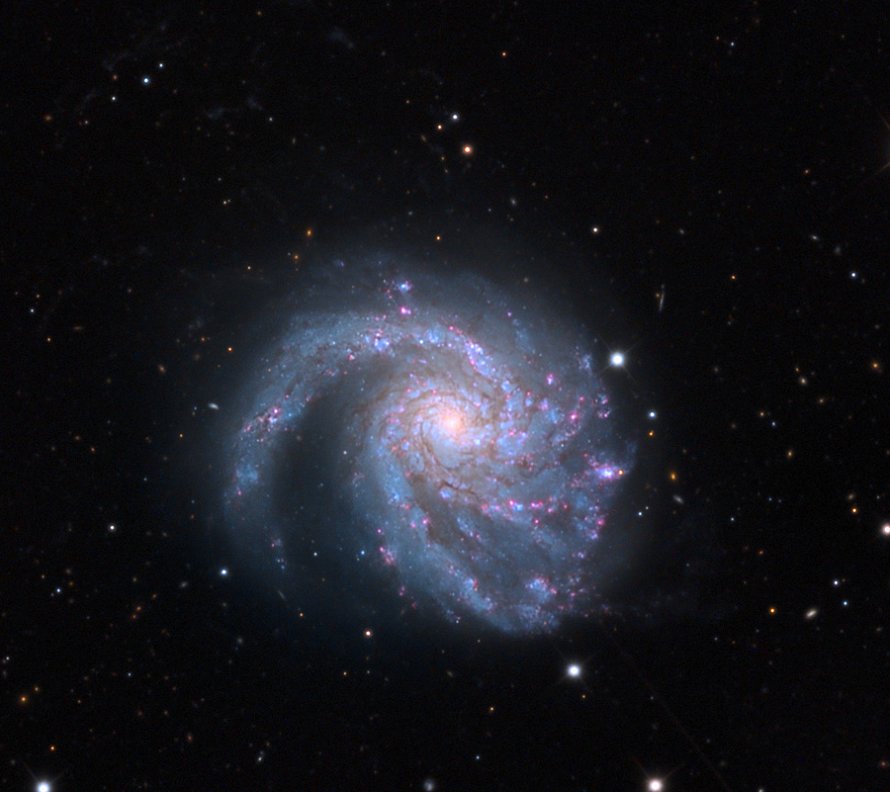M99 (NGC 4254)
Messier 99 (NGC 4254) is a spiral galaxy located in the constellation Coma Berenices in the Virgo Cluster of galaxies. M99 is 45200000 light years away from Earth.
M99 is best viewed during early spring, is magnitude 10.5, and can be viewed with small telescope. M99 is 5.4' x 4.7' in apparent size. For reference, the full moon is 30'.
Observing difficulty: Hard
- Name:
- Type:
- spiral galaxy
- Constellation:
- Coma Berenices
- NGC or IC:
- NGC 4254
- Magnitude:
- 10.5
- Viewing:
- small telescope
- Size:
- 5.4' x 4.7'
- Distance (light years):
- 45200000 LY
- RA:
- 12h 18.9m
- Dec:
- 14 26'
- Season:
- early spring
- Galaxy group:
- Virgo Cluster
- Messier Marathon #:
- 50
* The naked eye can see up to magnitude ~7-8 objects under ideal dark sky conditions.
The Coma Pinwheel Galaxy
Messier 99 (M99) is an unbarred spiral galaxy located in the constellation Coma Berenices. This galaxy was discovered by Pierre M?chain in 1781 and later catalogued by Charles Messier. M99 is part of the Virgo Cluster, a massive assembly of galaxies in the constellation Virgo and Coma Berenices, which is one of the densest galaxy regions near the Milky Way.
Physical Characteristics of Messier 99
M99 is an unbarred spiral galaxy, which is distinguished by its asymmetric spiral arms. It's also classified as a grand design spiral galaxy due to its well-defined spiral arms that extend around the galaxy. The spirals seem to be asymmetric, likely due to gravitational interaction with a nearby galaxy.
The galaxy spans about 5.4 x 4.8 arc minutes, which equates to an actual diameter of 50,000 light-years, about half the size of our Milky Way Galaxy. M99 is known to have a relatively high rate of star formation, particularly in its well-defined spiral arms, which is likely fueled by the galaxy's interaction with its neighbours.
Magnitude and Distance
Messier 99 lies approximately 50 million light-years away from Earth. It has an apparent magnitude of around 10.4, which makes it invisible to the naked eye but observable through small to medium-sized telescopes under dark sky conditions.
Finding and Observing Messier 99
Messier 99 is found within the constellation Coma Berenices, observable in the night sky from March to July. It's located near the star 6 Comae Berenices, which also serves as a marker for finding M98. M99 is approximately 1.3 degrees to the southeast of this star.
Even though M99 cannot be seen with the naked eye due to its faint magnitude, it is viewable through a small telescope or a pair of binoculars in clear, dark sky conditions. Observers can expect to see a faint, circular patch of light with a brighter core. The spiral arms of the galaxy are generally not discernible without larger telescopes or astrophotography.
As with many galaxies in the Virgo Cluster, the observation of M99 offers an opportunity to understand the cosmos better. Its asymmetric structure, likely due to gravitational interactions, allows astronomers to study the effects of galactic collisions and mergers, enriching our knowledge of galaxy formation and evolution.



